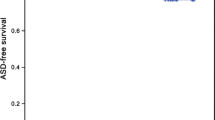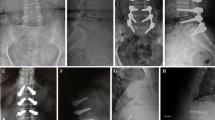Abstract
Segmental instability represents one of several different factors that may cause or contribute to the failed back surgery syndrome after lumbar microdiscectomy. As segmental lumbar instability poses diagnostic problems by lack of clear radiological and clinical criteria, only little is known about the occurrence of this phenomenon following primary microdiscectomy. Retrospectively, the records of 2,353 patients were reviewed according to postoperative symptomatic segmental single-level instability after lumbar microdiscectomy between 1989 and 1997. Progressive neurological deficits increased (mean of 24 months; SD: 12, range 1–70) after the initial surgical procedure in 12 patients. The mean age of the four men and eight women was 43 years (SD: 6, range 40–77). The main symptoms and signs of secondary neurological deterioration were radicular pain in 9 of 12 patients, increased motor weakness in 6 of 12 patients and sensory deficits in 4 of 12 patients. All 12 symptomatic patients had radiological evidence of segmental changes correlating with the clinical symptoms and signs. All but one patient showed a decrease in the disc height greater than 30% at the time of posterior spondylodesis compared with the preoperative images before lumbar microdiscectomy. All patients underwent secondary laminectomy and posterior lumbar sponylodesis. Postoperatively, pain improved in 8 of 9 patients, motor weakness in 3 of 6 patients, and sensory deficits in 2 of 4 patients. During the follow-up period of 72±7 months, one patient required a third operation to alleviate spinal stenosis at the upper end of the laminectomy. Patients with secondary segmental instability following microdiscectomy were mainly in their 40s. Postoperative narrowing of the intervertebral space following lumbar microdiscectomy is correlated to the degree of intervertebral disc resection. It can therefore be concluded that (1) patients in their 40s are prone to postoperative narrowing of the intervertebral disc space and hence subsequent intervertebral instability and (2) that a small extent of intervertebral disc resection and preservation of the “segmental frame” may be beneficial in those patients. The present study demonstrated for the first time that the degree of extensive operative techniques in microdiscectomy increased the risk of subsequent segmental instability. In addition, narrowing of the intervertebral space of more than 30% represents a clear radiological sign of segmental instability.
Similar content being viewed by others
References
Adams MA, Hutton WC (1983) The mechanical function of the lumbar apophyseal joints. Spine 8:327–330
Brodke DS, Dick JC, Kunz DN, et al (1997) Posterior lumbar interbody fusion. A biomechanical comparison, including a new threaded cage. Spine 22:26–31
Caspar W, Campell B, Barbier DD, et al (1991) The Caspar microsurgical discectomy and comparison with a conventional standard lumbar disc procedure. Neurosurgery 28:78–87
Cloward RB (1985) Posterior lumbar interbody fusion updated. Clin Orthop 193:16–19
Dick W (1987) The fixateur interne as a versatile implant for spine surgery. Spine 12:882–900
Dvorak J, Panjabi MM, Novotny JE, et al (1991) Clinical validation of functional flexion-extension roentgenograms of the lumbar spine. Spine 16:943–950
Ebara S, Harada T, Hosono N, et al (1992) Intraoperative measurement of lumbar spinal instability. Spine 17 (3S): S44–50
Gore DR, Sepic SB (1984) Anterior cervical fusion for degenerated or protruded discs: a review of one hundred forty-six patients. Spine 9:667–671
Grote W, Röttgen P (1967) The ventral fusion in cervical osteochondrosis and its treatment results. Acta Neurochir (Wien) 16:218–240
Ida Y, Kataoka O, Sho T, et al (1990) Postoperative lumbar spinal instability occurring or progressing secondary to laminectomy. Spine 15:1186–1189
Ishihara H, Matsui H, Hirano N, et al (1997) Lumbar intervertebral disc herniation in children less than 16 years of age. Spine 22:2044–2049
Ito M, Tadano S, Kaneda K (1993) A biomechanical definition of spinal segmental instability taking personal and disc level differences into account. Spine 18:2295–2304
Kaigle AM, Holm SH, Hansson TH (1995) Experimental instability in the lumbar spine. Spine 20:421–430
Kirkaldy-Willis WH, Farfan HF (1982) Instability of the lumbar spine. Clin Orthop 165:110–123
Klara PM, Foley KT (1993) Lumbar microdiscectomy. In: Rengachary SS, Wilkins RH (ed) Neurosurgical operative atlas, vol 3. Williams and Wilkins, Baltimore, pp 309–318
Knutsson F (1944) The instability associated with disc degeneration in the lumbar spine. Acta Radiol 25:593–609
Kotilainen E, Valtonen S (1993) Clinical instability of the lumbar spine after microdiscectomy. Acta Neurochir (Wien) 125:120–126
MacNab I (1971) The traction spur: an indicator of segmental instability. J Bone Joint Surg 53A:663–670
Mochida J, Nishimura K, Nomura T, et al (1996) The importance of preserving disc structure in surgical approaches to lumbar disc herniation. Spine 21:1556–1564
Nachemson A (1985) Lumbar spine instability: a critical update and symposium summary. Spine 10:290–291
Norton W (1987) Chemonucleolysis versus surgical discectomy: comparison of costs and results in workers’ compensation claimants. Spine 11:440–443
Padua R, Padua S, Romanini E, et al (1999) Ten- to 15-year outcome of surgery for lumbar disc herniation: radiographic instability and clinical findings. Eur Spin J 8:70–74
Reulen HJ, Müller A, Ebeling U (1996) Microsurgical anatomy of the lateral approach to extraforminal lumbar disc herniation. Neurosurgery 39:345–350
Schaller B, Mindermann T, Gratzl O (1999) Treatment of syringomyelia following posttraumatic para- or tetraparesis. J Spinal Dis 12:485–488
Shirazi-Adl A (1992) Finite-element simulation of changes in the fluid content of human lumbar discs: mechanical and clinical implications. Spine 17:206–212
Spangfort EV (1972) The lumbar disc herniation. A computer-aided analysis of 2504 operations. Acta Orthop Scand [Suppl] 142:5–95
Wiesel SW (1985) The multiply operated lumbar spine. Instr Course Lect 34:68–77
Word GW (1987) Lower back pain and disorders of the intervertebral disc. In: Campell’s operative orthopaedics. Mosby, St. Louis, pp 3255–3321
Author information
Authors and Affiliations
Corresponding author
Additional information
Presented in part at the International Congress on Pain Management and Failed Back Surgery Syndrome, Rotterdam, The Netherlands, November 9–12, 1998
Rights and permissions
About this article
Cite this article
Schaller, B. Failed back surgery syndrome: the role of symptomatic segmental single-level instability after lumbar microdiscectomy. Eur Spine J 13, 193–198 (2004). https://doi.org/10.1007/s00586-003-0632-x
Received:
Revised:
Accepted:
Published:
Issue Date:
DOI: https://doi.org/10.1007/s00586-003-0632-x




